Related Research Articles

Havana is the capital and largest city of Cuba. The heart of the La Habana Province, Havana is the country's main port and commercial center. It is the most populous city, the largest by area, and the second largest metropolitan area in the Caribbean region. The population in 2002 was 2,137,847 inhabitants, and its area is 728.26 km2 (281.18 sq mi) for the capital city side and 8,475.57 km² for the metropolitan zone.

Miramar is a residential district of the municipality of Playa, in the city of Havana.

Old Havana is the city-center (downtown) and one of the 15 municipalities forming Havana, Cuba. It has the second highest population density in the city and contains the core of the original city of Havana. The positions of the original Havana city walls are the modern boundaries of Old Havana.
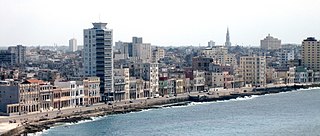
The Malecón is a broad esplanade, roadway, and seawall that stretches for 8 km along the coast in Havana, Cuba, from the mouth of Havana Harbor in Old Havana, along the north side of the Centro Habana neighborhood and the Vedado neighborhood, ending at the mouth of the Almendares.

Gaia is an arts centre in Havana, Cuba, set up on January 1, 2000, as a not-for-profit collaboration between Cuban and international artists.
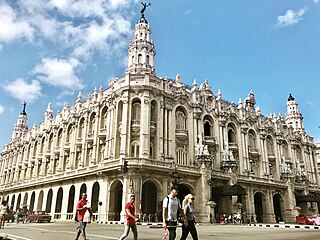
Gran Teatro de La Habana is a theater in Havana, Cuba, home to the Cuban National Ballet. It was designed by the Belgian architect Paul Belau and built by Purdy and Henderson, Engineers in 1914 at the site of the former Teatro Tacón. Its construction was paid for by the Galician immigrants of Havana to serve as a community-social center. Located in the Paseo del Prado, its facilities include theatres, a concert hall, conference rooms, a video screening room, as well as an art gallery, a choral center and several rehearsal halls for dance companies. It hosts the International Ballet Festival of Havana every two years since 1960.

The Teatro Nacional de Cuba is a theatre building in Havana, Cuba, on Plaza de la Revolución.

The Karl Marx Theatre is a theatre in Havana, Cuba. It was originally known as the Teatro Blanquita, owned and built by Alfredo Hornedo, renamed to the Teatro Charles Chaplin following the Cuban Revolution of 1959, and finally received its current name in 1975.

The Amadeo Roldán Theatre is a theatre in Havana, Cuba built in 1929. The theatre was destroyed in 1977 by a pyromaniac; it was re-opened in 1999 as the head office of the National Symphony Orchestra of Cuba which performs seasonal every Sunday at 11:00PM.

Iglesia de Jesús de Miramar is the second largest church in Cuba. It is located in the Roman Catholic Archdiocese of San Cristobal de la Habana.
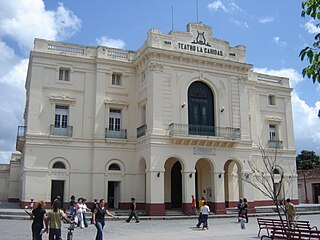
Teatro de La Caridad or Teatro La Caridad, located in Santa Clara, is one of the few remaining colonial theatres in Cuba. It is a National Monument of Cuba.

The Embassy of Russia in Havana is the headquarters of the diplomatic mission of the Russian Federation in the Republic of Cuba. It is well known for its striking constructivist building in the Miramar district of the city, built by architect Aleksandr Rochegov. Some liken it to a sword, others to a syringe.
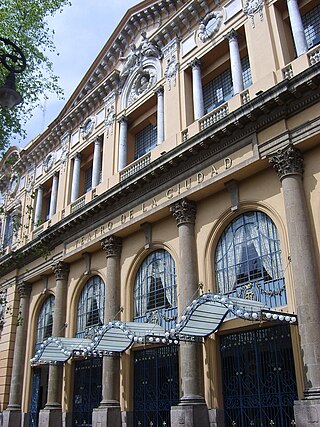
The Teatro de la Ciudad was built as the Teatro Esperanza Iris in 1918 and is now one of Mexico City’s public venues for cultural events. The theater is located in the historic center of Mexico City on Donceles Street 36.

Paseo del Prado is a street and promenade in Havana, Cuba, near the location of the old city wall, and the division between Centro Habana and Old Havana. Technically, the Paseo del Prado includes the entire length of Paseo Martí approximately from the Malecon to Calle Máximo Gómez, the Fuente de la India fountain. The promenade has had several names; it was renamed Paseo de Martí in 1898 with the island's independence from Spain. Despite the historic references, the people of Havana simply call it "El Prado".
The following is a timeline of the history of Havana, Cuba.
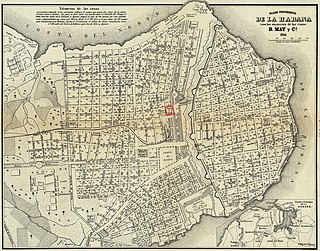
The Teatro Tacón opened in 1838 in Havana, Cuba. Its auditorium contained 2,750 seats. It was built by Pancho Martí, a businessman from Barcelona who moved to Havana, and named after Miguel Tacón y Rosique, Governor of Cuba from 1834 to 1838. In 1847 Bottesini's opera Cristoforo Colombo premiered there. By 1855, so many people attended events that the city issued parking regulations for carriages on performance nights.

The Parque Central, Havana is one of the best known and central sites of the city of Havana, Cuba. It is located between Prado, Neptuno, Zulueta and San José streets, and San Rafael Boulevard. Among the buildings surrounding the park are Gran Teatro de La Habana, the Hotel Inglaterra, the Hotel Telégrafo, el Hotel Parque Central, la Manzana de Gómez, the Hotel Plaza and Museo Nacional de Bellas Artes.
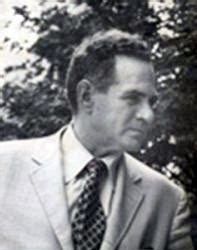
Mario Romañach (1917–1984) was a Cuban modernist architect, planner, and university professor.

Alfredo Hornedo y Suárez was a senator of the Liberal Party. Owner of the Mercado Único, the Mercado de Carlos III, the Casino Deportivo of Havana, and the news papers El Pais, Excelsior, El Sol, and El Crisol. He built the Teatro Blanquita, the Hotel Rosita Hornedo, and the Riomar Building. He owned various radio stations.

The Coliseo of Havana was the first theatre built in Havana, constructed on January 20, 1775. It was built near the Alameda de Paula between Calles Acosta, Oficios, and Luz, in Old Havana.